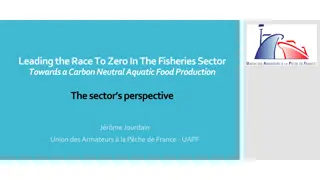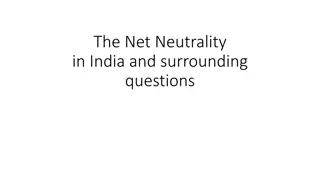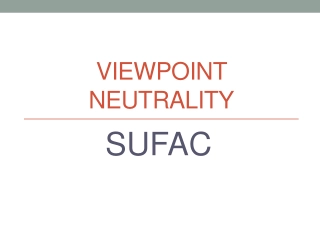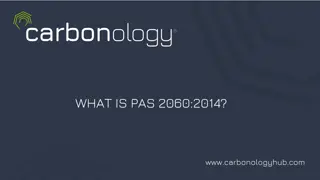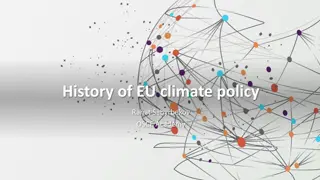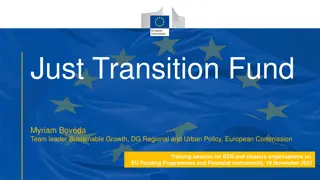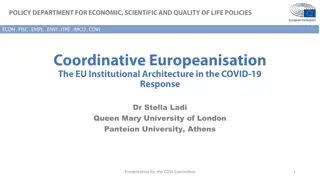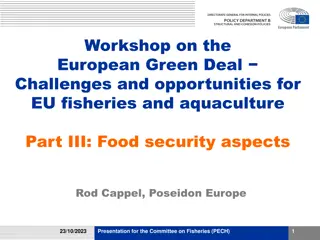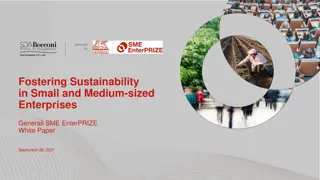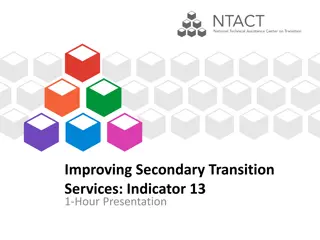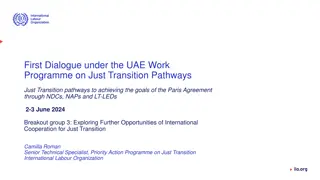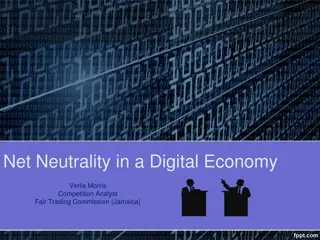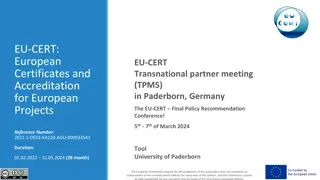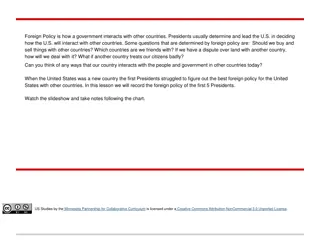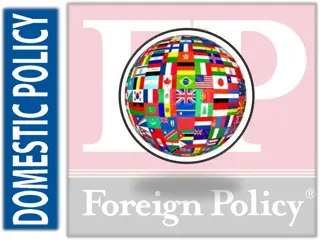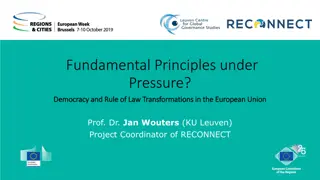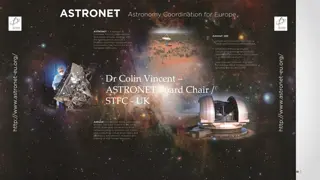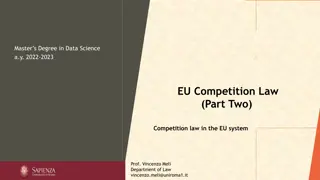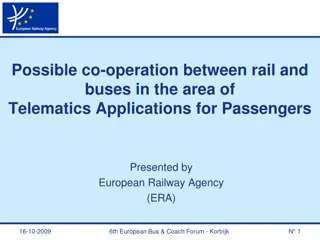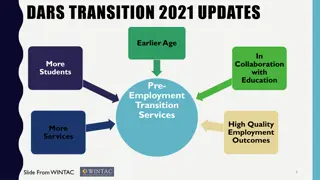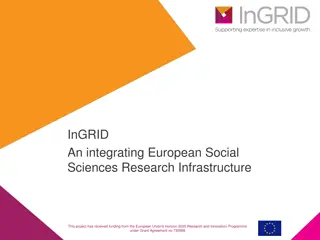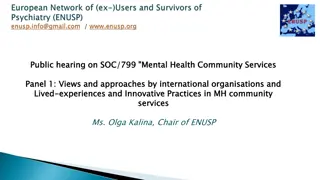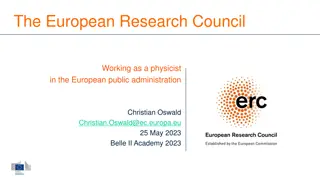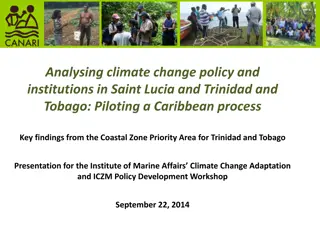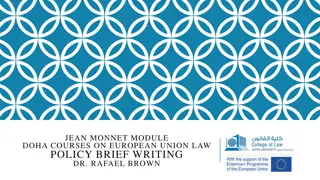European Climate Policy and Transition to Climate Neutrality
European climate policy focus on sharp emission limits, socially acceptable transition measures, and global involvement for a successful transition to climate neutrality. Key elements include ETS, emission allowances, and Fit for 55 proposal to achieve climate neutrality by 2050.
Download Presentation

Please find below an Image/Link to download the presentation.
The content on the website is provided AS IS for your information and personal use only. It may not be sold, licensed, or shared on other websites without obtaining consent from the author. Download presentation by click this link. If you encounter any issues during the download, it is possible that the publisher has removed the file from their server.
E N D
Presentation Transcript
Climate change - European climate policy John Hassler Institute for International Economic Studies Stockholm University
Climate policy The transition to climate neutrality is not of historic proportions, but the fossil economy is not phased automatically. Policy is needed! Three complementary policy areas: 1. Set sharp emission limits (tax or emission trading systems). 2. Policies that make the transition socially, economically and politically acceptable. 3. Measures that get the rest of the world involved in the transition. Climate policy needs to be successful in all areas. Can EU be a forerunner? Institute for International Economic Studies Stockholm University
Taxes vs emission allowances Emission price in the form of Pigouvian tax natural for economists. Seems less natural to voters and policy makers. Emission Trading Systems (ETS) perhaps more so. Preferred choice in many countries -- EU and China. Proportionality of climate change to accumulated emissions implies that emissions needs to stop and given a temperature target, a global carbon emission budget can be calculated. This carbon budget is a natural resource in scarce supply. Cannot be up for grabs . Emission trading system a natural solution. Arguably easier to explain to people and policy makers than marginal damage needs to be internalized . Institute for International Economic Studies Stockholm University The larger the scope of an ETS, the better it works.
Fit for 55 a game changer Three key elements of EU commission proposal for policies to reach climate neutrality by 2050. Agreed upon in trilouge December 2022. 1. Twice as fast de-escalation of issuance of EU ETS allowances. End date 2040. Total emissions 16 billion tons. Institute for International Economic Studies Stockholm University
EU ETS new emission allowances Decision 2008 Decision 2018 Proposal 2021 Source: EU Commission Communication COM(2020) 562 final, Sept 17, 2020 Institute for International Economic Studies Stockholm University
EU policy Three key elements of EU commission proposal for policies to reach climate neutrality by 2050. 1. Twice as fast de-escalation of issuance of EU ETS allowances. End date 2040. Total emissions 16 billion tons. 2. New emissions trading system for transport and heating. Issuance ends in 2044. Institute for International Economic Studies Stockholm University
New ETS for transport and heating Auctioning volume of emission allowances million per year Auctioning 2028-43 Auctioning 2026-27 ESR no auctioning Institute for Bild: Nu r det p allvar , Lennart Nilsson produktion, 2021. International Economic Studies Stockholm University
EU policy Three key elements of EU commission proposal for policies to reach climate neutrality by 2050. 1. Twice as fast de-escalation of issuance of EU ETS allowances. End date 2040. Total emissions 16 billion tons. 2. New emissions trading system for transport and heating. Issuance ends in 2044. 3. Faster reduction in average emissions requirements from new cars. Minus 55% by 2030. No sales of fossil cars after 2035. Gives full control over almost all future CO2 emissions in union. Accumulated emissions of CO2 by 2050 around 30 Gt. 70 ton per EU citizen. Contributesabout 0.02 C to final global warming. 70 ton per world citizen gives 560 GtCO2 . IPCC global carbon budget for 1.5 C 400 Gt and for 2 C 1150 Gt. Fully consistent with Paris agreement ambition. Institute for International Economic Studies Stockholm University
Implications for national policy National policies as well as company polices focusing on emission levels and carbon footprints become obsolete. But, what about the Effort Sharing Regulation? National policy can focus on making the transition smooth. Required for political and popular support. Key for climate that society works. This transition is not larger, faster or more fundamental than other transitions (industrialization, digitalization, ). But it requires policies that phase out the fossil society by setting sharp emission limits. A changed life-style probably not important component in transition to carbon neutrality (IEA, Net Zero 2050). Institute for International Economic Studies Stockholm University
Change of lifestyle? Limited need for lifestyle changes e.g., changed means of transportation and less flying. Institute for International Economic Studies Stockholm University IEA, 2021, Net Zero By 2050.
GDP-effect of Net-Zero by 2050 Institute for International Economic Studies Stockholm University Figur 3.9 IMF WEO Chap 3, Oct 2020.
Climate and finance Taxonomy (EU policy that classifies economic activities as sustainable or not) is costly and cannot reduce emissions in EU under new rules. Private incentives and climate targets become aligned. Markets then better than politicians to allocate capital. Green bonds not key for the transition in EU. Capital not in short supply. Financial stability risks associated with stranded assets neither qualitatively nor quantitatively different from other risks. Evidence points towards few such assets in developed world. Institute for International Economic Studies Stockholm University
Stranded Assets IEA, 2021, Net Zero By 2050. Institute for International Economic Studies Stockholm University
Oil and gas production consistent with global Net-Zero by 2050 Institute for International Economic Studies Stockholm University IEA, 2021, Net Zero By 2050.
Climate and finance Taxonomy (EU policy that classifies economic activities as sustainable or not) is costly and cannot reduce emissions in EU under new rules. Private incentives and climate targets become aligned. Markets then better than politicians to allocate capital. Green bonds not key for the transition in EU. Capital not in short supply. Financial stability risks associated with stranded assets neither qualitatively nor quantitatively different from other risks. Evidence points towards few in developed world. Standard tools to analyze risks can and should be applied. Institute for Global investment needs to increase but not to unprecedented levels. International Economic Studies Stockholm University
Investments Increased global investment rate. 1% of GDP higher 2020-2050. Peak 2030, then 2% higher. (Global investment share 2010-19 24.4%, 1970-1999 26.1%) GDP Institute for International Economic Studies Stockholm University
Some policy conclusions 1. Even a modest emission price is quite effective in dealing with climate change. Reduces use and steers technical change towards green. 2. Emission prices must have broad global coverage. We cannot do it without China, India and Africa on board. 3. Making the world climate neutral to 2050 can be done at reasonable cost. It is the robust policy providing a cheap and possibly highly valuable insurance. The economy is flexible in the medium and long run. 4. EU is now on its way to do what is required. With the right transition policy, climate neutrality by 2050 can be achieved smoothly. Plan B (geoengineering) should also be prepared. 5. Institute for 6. Reasons to be cautiously optimistic. International Economic Studies Stockholm University
Suggestions for research 1. Refining cost-benefit based integrated assessment models to find the global optimal carbon price arguably of little policy relevance. But models remain highly useful. Integrate EU-climate policy in climate-economy modeling (for EU). 2. 3. EU will (likely) decarbonize at a reasonable pace using emission trading. ETS aligns private and social incentives. Are there important obstacles and market failures? Risk for carbon leakage? Technology transfers? 4. Analyze risks to financial stability with standard tools. Identify, quantify and draw policy conclusions. 5. Strongly felt need for policy makers to show that they care about climate change. Mostly words but also risk of bad policy and wrong focus. We have a responsibility to counteract this. Institute for International Economic Studies Stockholm University
References IPCC 6e rapporten WG 1, https://www.ipcc.ch/report/sixth-assessment-report-working-group-i/ IEA, International Energy Agency, Net Zero By 50, https://www.iea.org/reports/net-zero-by-2050 IMF, World Economic Outlook, October 2020, Chapter 3, https://www.imf.org/en/Publications/WEO/Issues/2020/09/30/world-economic-outlook-october-2020 Directed technical change as a response to natural-resource scarcity , med P Krusell och C Olovsson, JPE, 2021, http://hassler-j.iies.su.se/PAPERS/ESTC.pdf Suboptimal climate policy , JEEA, med P Krusell och C Olovsson http://hassler- j.iies.su.se/PAPERS/suboptimal_CO2.pdf Climate policy in need of plan B , med C Fuglesang, http://hassler-j.iies.su.se/PAPERS/PlanB.pdf Institute for International Economic Studies Stockholm University



